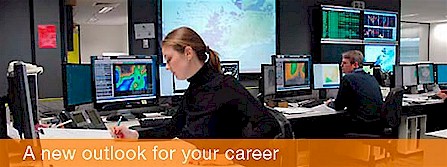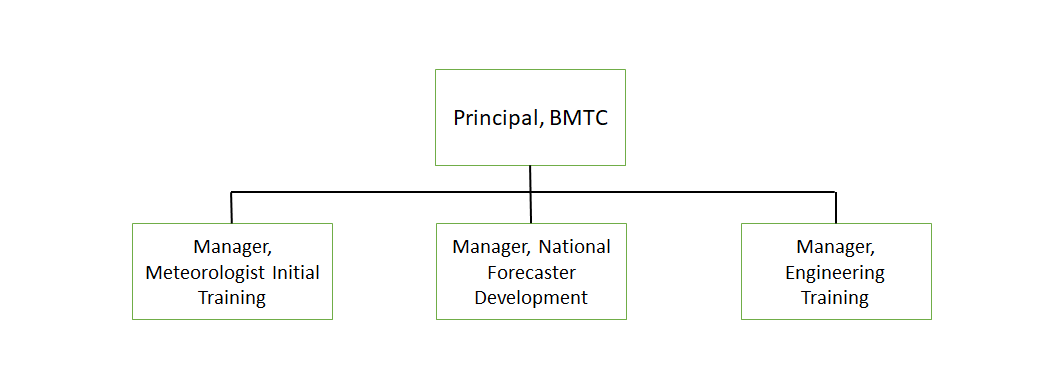Graduate Diploma in Meteorology
Section outline
-

So you want to study towards a career as a meteorologist?
The Bureau of Meteorology
The Commonwealth of Australia Bureau of Meteorology (hereafter the Bureau) trading as the Bureau of Meteorology Training Centre (hereafter BMTC) operates under the authority of the Meteorology Act 1955 and the Water Act 2007 which provide the legal basis for its activities.
The Bureau is led by its CEO and Director, Andrew Johnston. For more information on our organisational structure see here. Our latest annual report (including our financial standing) is found here.
Under the Meteorology Act, the Director has the power to “arrange for the training of persons in meteorology.” This is where BMTC comes in.
BMTC
We are a registered higher education provider under the Tertiary Education Quality and Standards Agency (TEQSA) (PRV12118). BMTC is also registered with the Commonwealth Register of Institutions and Courses for Overseas Students (CRICOS) to provide training for international students studying on an Australian student visa under the ESOS Act (2003) – CRICOS Provider Number 02015K. All our course offerings in meteorology are recognised by the World Meteorological Organization (WMO) as meeting the standard for the education of operational meteorologists.
As a global meteorological educator BMTC has a reputation for excellence, particularly in tropical meteorology and satellite meteorology.
Our courses
BMTC offers two courses in meteorology.
- The Basic Instruction for Meteorologists (BIP-M) is a non-accredited course, recognised by the WMO as meeting the required standard for the training of qualified meteorologists. This course is of 31 weeks duration.
- The Graduate Diploma in Meteorology is an accredited degree (AQF 8), CRICOS Course Code 033984D. This course is of 41 weeks duration, and is inclusive of the BIP-M. This course also includes instruction on forecast services and systems and job simulation. The Graduate Diploma learning objective is to produce a variety of forecasts to an appropriate standard, in the relevant format and to demonstrate a deeper level of knowledge of tropical meteorological theory.
Key benefits:
- Internationally recognised Meteorologist qualification.
- Role-focussed learning approach for easy transition to a career as an operational meteorologist.
- Purpose built training facilities.
- Highly qualified teaching staff, all with operational experience.
The role-focused learning approach allows for easy transition to a career as an operational meteorologist. Students will study in purpose-built training facilities, taught by highly qualified teaching staff, all with operational experience.
After completing the course students will be able to:
- Demonstrate a sound level of knowledge of meteorological theory and forecast procedures.
- Use observation data to analyse the current state of the atmosphere.
- Use available technologies to view observation data and model guidance.
- Communicate current and forecast weather conditions in a way that is suitable for media, general public and specialised users.
- And demonstrate the capacity to work as an effective team member in a service-oriented team.
Full details are available in our Handbook, which is provided upon enrolment.
Dates for 2025:
- BIP-M and Graduate Diploma commence: Monday 28 January
- BIP-M concludes: Friday 19 September
- Graduate Diploma course graduation: Thursday 12 November
Assessment
Assessment occurs throughout the course via written examinations, written assignments, and practical work. Some modules are graded, while others are assessed via competency standards.
Our staff
The majority of the BIP-M and Graduate Diploma are delivered by meteorologists with at least a Masters degree, or extensive operational meteorological experience, from the Meteorologist Initial Training team, comprising of six teaching staff and a manager. Units are also delivered by the National Forecaster Development team, who are responsible for the assessment of the competency of operational staff and provide training in job preparedness. Some training on meteorological observations is also provided by the Engineering Training team.

Our campuses and facilities
Both of our campuses are in Melbourne, Victoria. Most classes are located at our main campus at 1-41 Glenlitta Avenue, Broadmeadows, 3047. Our modern campus contains a lecture theatre, and student home rooms with workstations. Laptops are provided to all students to use with these workstations.
Graduates will also attend some classes at the Bureau of Meteorology’s Head Office at 700 Collins Street, Docklands, 3001.
Melbourne is known for its varied and dynamic culture. It is rated as Australia’s best and most livable city for students.
Students are supplied with all the information needed to complete their studies and are not required to purchase textbooks. In addition to digital and printed material produced by BMTC, students have access to the National Meteorological Library on the 9th floor of 700 Collins Street.
In addition to timetabled classes, students can request extra tuition. Students may also access the Employee Assistant Program (EAP) to help resolve personal issues affecting their performance.
How to apply
Entry into the Graduate Diploma or BIP-M is via the Bureau’s Graduate Meteorologist Program or by sponsorship from a domestic or international meteorological organisation. Bureau graduates complete the Graduate Diploma. Enrolments vary from year to year due to operational requirements, anywhere between 10 – 40. Most external graduates also complete the Graduate Diploma, and enrolments depend on the needs of external agencies, anywhere between 0 – 10.
Prospective students are required to have a Bachelor's degree, majoring in a physical science or mathematics; with mathematics and physical science to second-year level. Bureau graduates must also be Australian citizens.
Overseas candidates should demonstrate English proficiency and therefore are required to complete an internationally recognised test such as the TOEFL & IELTS. The standard of English indicated by these results is similar to that required by most Australian Universities for international students.
- TOEFL: minimum score of 550 (paper-based test) or 213 (computer-based test).
- IELTS: a minimum score of 6.5.
International students need to be nominated by their supporting organisation. To nominate for enrolment, download the nomination form on the Graduate Diploma website.
Course Cost
The Graduate Diploma is available to international students on a fee-paying basis. These students need to be nominated and supported by a Meteorological agency, which includes funding their course fees, travel, accommodation and living expenses. Fees are refunded to the sponsoring institution on a pro-rata basis in the event a student's enrolment is cancelled or the student withdraws from the course. More details are provided in the Course Handbook which is provided upon enrolment.
The course fees for 2026 are $36,324 (TBC) for the Basic Instruction Package for Meteorologists and $45,405 (TBC) for the Graduate Diploma in Meteorology.
Complaints procedures
As both a registered higher education provider, and part of the Australian Public Service, BMTC has a grievance procedure for dealing with academic and non-academic complaints. The details of these procedures are provided on enrolment.
If you have exhausted these grievance procedures and are still not satisfied with the outcome, you can contact the Ombudsman or the Australian Competition and Consumer Commission (ACCC). For more details, see the Study Assist website.
Further information
For any other information or enquiries please contact srtp@bom.gov.au
CRICOS Provider Number 02015K. CRICOS Course Code 033984D
